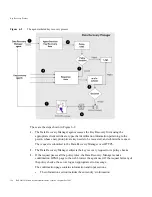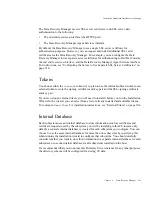
Installing a Standalone Data Recovery Manager
Chapter 6
Data Recovery Manager
205
The Data Recovery Manager uses its SSL server certificate to do SSL server-side
authentication to the following:
•
The end entity services interface (the HTTPS port)
•
The Data Recovery Manager Agent Services interface
By default, the Data Recovery Manager uses a single SSL server certificate for
authentication purposes. However, you can request and install additional SSL server
certificates for the Data Recovery Manager. For example, you can configure the Data
Recovery Manager to use separate server certificates for authenticating to Red Hat Console,
the end entity services interface, and the Data Recovery Manager Agent Services interface.
For instructions, see “Configuring the Server to Use Separate SSL Server Certificates” on
page 310.
Tokens
You choose either the
internal
token (if you plan to use the internal/software token) or an
external token to store the signing certificate and key pair and the SSL signing certificate
and key pair.
If you are using an external token, you will need to install it before you run the Installation
Wizard. In the wizard, you can select from a list of already installed and available tokens.
For example,
SmartCard
. For installation instructions, see “External Token” on page 306.
Internal Database
Each subsystem uses an internal database to store information (such as certificates and
certificate requests) used by the subsystem you will be installing in this CS instance. By
default, a separate internal database is created for each subsystem you configure. You can
choose to use the same internal database for more than one subsystem by specifying this
when running the installation wizard to configure that subsystem. You should carefully
consider whether you want to store this information in a separate internal database for each
subsystem or use one internal database for all subsystems installed on the host.
It’s recommended that you do not use this Directory Server instance for any other purposes;
the directory schema will be configured for storing CS data.
Summary of Contents for CERTIFICATE 7.1 ADMINISTRATOR
Page 1: ...Administrator s Guide Red Hat Certificate System Version7 1 September 2005 ...
Page 22: ...22 Red Hat Certificate System Administrator s Guide September 2005 ...
Page 128: ...Cloning a CA 128 Red Hat Certificate System Administrator s Guide September 2005 ...
Page 368: ...ACL Reference 368 Red Hat Certificate System Administrator s Guide September 2005 ...
Page 460: ...Constraints Reference 460 Red Hat Certificate System Administrator s Guide September 2005 ...
Page 592: ...CRL Extension Reference 592 Red Hat Certificate System Administrator s Guide September 2005 ...






























